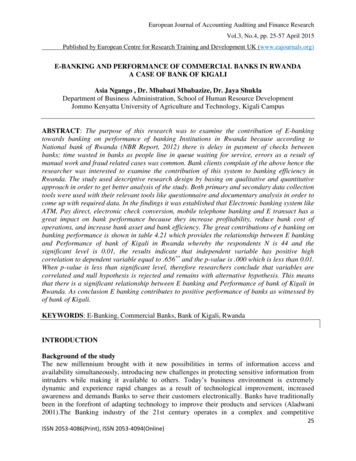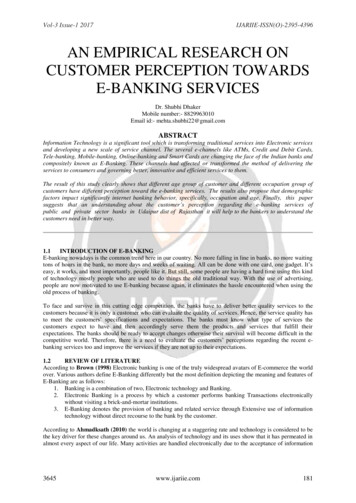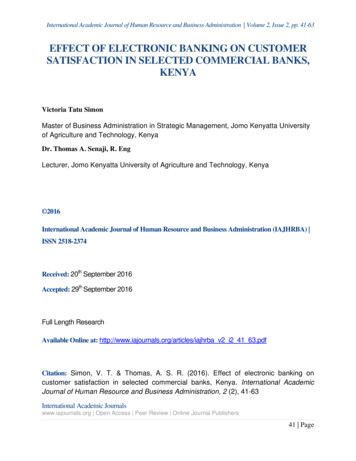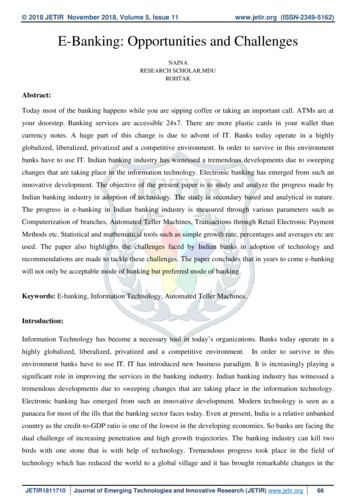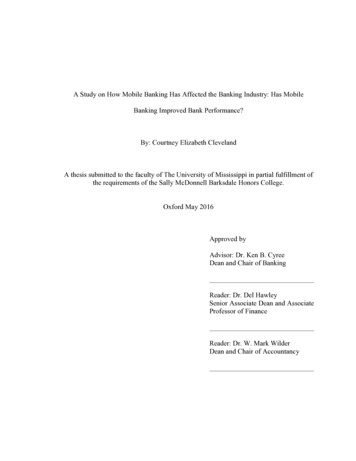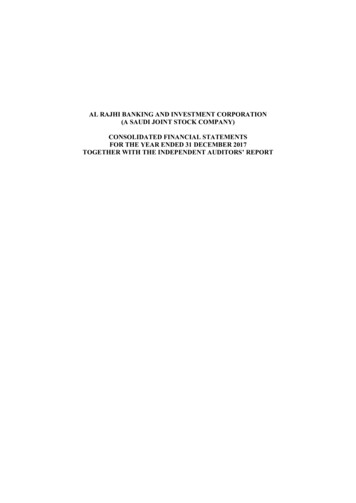
Transcription
AL RAJHI BANKING AND INVESTMENT CORPORATION(A SAUDI JOINT STOCK COMPANY)CONSOLIDATED FINANCIAL STATEMENTSFOR THE YEAR ENDED 31 DECEMBER 2017TOGETHER WITH THE INDEPENDENT AUDITORS’ REPORT
AL RAJHI BANKING AND INVESTMENT CORPORATIONNOTES TO CONSOLIDATED FINANCIAL STATEMENTS (Continued)FOR THE YEARS ENDED 31 DECEMBER 2017 AND 20161.GENERALa) Incorporation and operationAl Rajhi Banking and Investment Corporation, a Saudi Joint Stock Company, (the “Bank”),was formed and licensed pursuant to Royal Decree No. M/59 dated 3 Dhul Qadah 1407H(corresponding to June 29, 1987) and in accordance with Article 6 of the Council ofMinisters’ Resolution No. 245, dated 26 Shawal 1407H (corresponding to June 23, 1987).The Bank operates under Commercial Registration No. 1010000096 and its Head Office islocated at the following address:Al Rajhi BankOlaya StreetP.O. Box 28, Riyadh 11411Kingdom of Saudi ArabiaThe objectives of the Bank are to carry out banking and investment activities in accordancewith its Articles of Association and By-Laws, the Banking Control Law and the Council ofMinisters’ Resolution referred to above. The Bank is engaged in banking and investmentactivities inside and outside the Kingdom of Saudi Arabia through 599 branches (2016: 584)including the branches outside the Kingdom and 13,077 employees (2016: 13,546employees). The Bank has established certain subsidiary companies (together with the Bankhereinafter referred to as "the Group") in which it owns all or majority of their shares as setout below (Also see note 3(b)):Name of subsidiariesBeneficialShareholding%20162017Al Rajhi Development Company KSA100%100%Al Rajhi Corporation Limited –Malaysia100%100%8A limited liability companyregistered in the Kingdom of SaudiArabia to support the mortgageprograms of the Bank throughtransferring and holding the titledeeds of real estate properties underits name on behalf of the Bank,collection of revenue of certainproperties sold by the Bank ,provide real estate and engineeringconsultingservices,providedocumentation service to registerthe real estate properties andoverseeing the evaluation of realestate properties.A licensed Islamic Bank under theIslamic Financial Services Act2013, incorporated and domiciled inMalaysia.
AL RAJHI BANKING AND INVESTMENT CORPORATIONNOTES TO CONSOLIDATED FINANCIAL STATEMENTS (Continued)FOR THE YEARS ENDED 31 DECEMBER 2017 AND 20161.GENERAL (continued)a) Incorporation and operation (continued)Al Rajhi Capital Company – KSABeneficialShareholding%20162017100% 100%Al Rajhi Bank – Kuwait100%100%Al Rajhi Bank – Jordan100%100%Al Rajhi Takaful Agency Company– KSA99%99%Al Rajhi Company for managementservices – KSA100%100%Name of subsidiariesA limited liability company registeredin the Kingdom of Saudi Arabia to actas principal agent and/or to providebrokerage, underwriting, managing,advisory, arranging and custodialservices.A foreign branch registered with theCentral Bank of Kuwait.A foreign branch operating inHashimi Kingdom of Jordan,providing all financial, banking, andinvestments services and importingand trading in precious metals andstones in accordance with IslamicSharia’a rules and under theapplicable banking law.A limited liability company registeredin the Kingdom of Saudi Arabia to actas an agent for insurance brokerageactivities per the agency agreementwith Al Rajhi Cooperative InsuranceCompany.A limited liability company registeredin the Kingdom of Saudi Arabia toprovide recruitment services.The subsidiaries are wholly or substantially owned by the Bank and therefore, the noncontrolling interest which is insignificant is not disclosed. All the above-mentionedsubsidiaries have been consolidated. As of 31 December 2017 and 2016, interests insubsidiaries not directly owned by the Bank are owned by representative shareholders forthe beneficial interest of the Bank.b) Shari’a AuthorityAs a commitment from the Bank for its activities to be in compliance with Islamic Shari’alegislations, since its inception, the Bank has established a Shari’a Authority to ascertainthat the Bank’s activities are subject to its approval and control. The Shari’a Authority hadreviewed several of the Bank’s activities and issued the required decisions thereon.2.BASIS OF PREPARATIONa) Statement of complianceThe (consolidated) financial statements of the Bank (Group) have been prepared;-in accordance with ‘International Financial Reporting Standards (IFRS) as modifiedby SAMA for the accounting of zakat and income tax’, which requires, adoption of9
AL RAJHI BANKING AND INVESTMENT CORPORATIONNOTES TO CONSOLIDATED FINANCIAL STATEMENTS (Continued)FOR THE YEARS ENDED 31 DECEMBER 2017 AND 20162.BASIS OF PREPARATION (continued)a) Statement of compliance (continued)-all IFRSs as issued by the International Accounting Standards Board (“IASB”) exceptfor the application of International Accounting Standard (IAS) 12 - “Income Taxes”and IFRIC 21 - “Levies” so far as these relate to zakat and income tax. As per theSAMA Circular no. 381000074519 dated April 11, 2017 and subsequent amendmentsthrough certain clarifications relating to the accounting for zakat and income tax(“SAMA Circular”), the Zakat and Income tax are to be accrued on a quarterly basisthrough shareholders equity under retained earnings.in compliance with the provisions of Banking Control Law, the Regulations forCompanies in the Kingdom of Saudi Arabia and the Article of Association of theBankFurther, the above SAMA Circular has also repealed the existing Accounting Standards forCommercial Banks, as promulgated by SAMA, and are no longer applicable from January 1,2017.Refer note 3(l) for the accounting policy of zakat and income tax and note 3(a) for the impactof change in the accounting policy resulting from the SAMA Circular.b)Basis of measurement and preparationThe consolidated financial statements are prepared under the historical cost convention exceptfor the measurement at fair value of investments held as fair value through income statement(“FVSI”) and available-for-sale investments.The Bank presents its statement of financial position in order of liquidity. An analysisregarding recovery or settlement within 12 months after the reporting date (current) and morethan 12 months after the reporting date (non–current) is presented in note 26-2.c)Functional and presentation currencyThe consolidated financial statements are presented in Saudi Arabian Riyals (“SAR”),which is the Bank’s functional currency and are rounded off to the nearest thousand exceptotherwise indicated.d)Critical accounting judgments, estimates and assumptionsThe preparation of consolidated financial statements in conformity with IFRS requires theuse of certain critical accounting estimates and assumptions that affect the reported amountsof assets and liabilities. It also requires management to exercise its judgments in the processof applying the Bank’s accounting policies. Such estimates, assumptions and judgments arecontinually evaluated and are based on historical experience and other factors, includingobtaining professional advice and expectations of future events that are believed to bereasonable under the circumstances. The resulting accounting estimates will, by definition,seldom equal to related actual results.10
AL RAJHI BANKING AND INVESTMENT CORPORATIONNOTES TO CONSOLIDATED FINANCIAL STATEMENTS (Continued)FOR THE YEARS ENDED 31 DECEMBER 2017 AND 20162.BASIS OF PREPARATION (continued)d) Critical accounting judgments, estimates and assumptions (continued)The key assumptions concerning the future and other key sources of estimation uncertaintyat the reporting date, that have a significant risk of causing a material adjustment to thecarrying amounts of assets and liabilities within the next financial year, are describedbelow. The Bank based its assumptions and estimates on parameters available when theconsolidated financial statements were prepared. Existing circumstances and assumptionsabout future developments, however, may change due to market changes or circumstancesbeyond the control of the Bank. Such changes are reflected in the assumptions when theyoccur. Significant areas where management has used estimates, assumptions or exercisedjudgments is as follows:i)Impairment on financingThe Bank reviews its financing portfolios to assess specific and collective impairmenton a quarterly basis.The specific impairment applies to financing evaluated individually for impairment andis based on management’s best estimate of the present value of the cash flows that areexpected to be received. In estimating these cash flows, management makes judgmentsabout a customer’s financial situation and the net realisable value of any underlyingcollateral. This evidence may include observable data indicating that there has been anadverse change in the payment status of clients in a group. The methodology andassumptions used for estimating both the amount and the timing of future cash flowsare reviewed regularly to reduce any differences between loss estimates and actual lossexperience. Each impaired asset is assessed on its merits and the workout strategy andestimate of cash flows considered recoverable are independently approved by the CreditRisk function.A collective component of the total allowance is established for groups ofhomogeneous financing that are not considered individually significant and isestablished using statistical methods such as roll rate methodology and internal lossestimates. The methodology uses statistical analysis of historical data on delinquency toestimate the amount of loss. Management applies judgement to ensure that the estimateof loss arrived at on the basis of historical information is appropriately adjusted toreflect the economic conditions and product mix at the reporting date. Roll rates andloss rates are regularly benchmarked against actual loss experience.In assessing the need for collective loss allowance, management considers factors suchas credit quality, portfolio size, concentrations and economic factors. To estimate therequired allowance, assumptions are made to define how inherent losses are modelledand to determine the required input parameters, based on historical experience andcurrent economic conditions. The accuracy of the allowance depends on the modelassumptions and parameters used in determining the collective allowance. (Also seenote 3(i), 7 and 26).ii)Impairment of available for-sale and sukuk investmentsThe Bank exercises judgement to consider impairment on the available-for-sale equityinvestments at each reporting date. This includes determination of a significant orprolonged decline in the fair value below its cost. In assessing whether it is significant,the decline in fair value is evaluated against the original cost of the asset at initialrecognition. The determination of what is 'significant' or 'prolonged' requiresjudgement. In making this judgement, the Bank evaluates among other factors, the11
AL RAJHI BANKING AND INVESTMENT CORPORATIONNOTES TO CONSOLIDATED FINANCIAL STATEMENTS (Continued)FOR THE YEARS ENDED 31 DECEMBER 2017 AND 20162.d)BASIS OF PREPARATION (continued)Critical accounting judgments, estimates and assumptions (continued)ii) Impairment of available for-sale and sukuk investments (continued)normal volatility in share price, deterioration in the financial health of the investee,industry and sector performance, changes in technology, and operational and financingcash flows. The Bank reviews its investments in sukuks at each reporting date to assesswhether they are impaired. This requires similar judgement as applied to individualassessment of financing. In addition, the Bank considers impairment to be appropriatewhen there is evidence of deterioration in the financial health of the investee, industryand sector performance, changes in technology, and operational and financing cashflows. (Also see note 3(i) and 6).iii)Fair value of financial instrumentsThe Group measures financial instruments at fair value at each balance sheet date.Fair value is the price that would be received to sell an asset or paid to transfer aliability in an orderly transaction between market participants at the measurement date.The fair value measurement is based on the presumption that the transaction to sell theasset or transfer the liability takes place either: In the principal market for the asset or liability, orIn the absence of a principal market, in the most advantageous market for theasset or liabilityThe principal or the most advantageous market must be accessible to by the Group.The fair value of an asset or a liability is measured using the assumptions that marketparticipants would use when pricing the asset or liability, assuming that marketparticipants act in their economic best interest.A fair value measurement of a non-financial asset takes into account a marketparticipant's ability to generate economic benefits by using the asset in its highest andbest use or by selling it to another market participant that would use the asset in itshighest and best use.The Bank uses valuation techniques that are appropriate in the circumstances and forwhich sufficient data are available to measure fair value, maximising the use of relevantobservable inputs and minimising the use of unobservable inputs.All assets and liabilities for which fair value is measured or disclosed in the financialstatements are categorized within the fair value hierarchy, described as follows, basedon the lowest level input that is significant to the fair value measurement as a whole:- Level 1 — Quoted (unadjusted) market prices in active markets for identical assets orliabilities- Level 2 — Inputs other than quoted prices included within Level 1 that are observableeither directly (i.e. as prices) or indirectly (i.e. derived from prices). This categoryincludes instruments valued using: quoted market prices in active markets forsimilar instruments; quoted prices for identical or similar instruments in marketsthat are considered less than active; or other valuation techniques in which allsignificant inputs are directly or indirectly observable from market data.- Level 3 — Valuation techniques for which the lowest level input that is significant tothe fair value measurement is unobservable. (Also see note 28).12
AL RAJHI BANKING AND INVESTMENT CORPORATIONNOTES TO CONSOLIDATED FINANCIAL STATEMENTS (Continued)FOR THE YEARS ENDED 31 DECEMBER 2017 AND 20162.BASIS OF PREPARATION (continued)d)Critical accounting judgments, estimates and assumptions (continued)iv) Classification of investments held at amortised costThe Bank follows the guidance of IAS 39 on classifying non-derivative financial assetswith fixed or determinable payments and fixed maturity as Investments held atamortised cost.v)Determination of control over investeesThe control indicators set out in note 3 (b) are subject to management’s judgements thatcan have a significant effect in the case of the Bank’s interests in investments funds.Investment fundsThe Group acts as Fund Manager to a number of investment funds. Determiningwhether the Group controls such an investment fund usually focuses on the assessmentof its aggregate economic interests of the Group in the Fund (comprising any carriedprofits and expected management fees) and the investor’s rights to remove the FundManager. As a result the Group has concluded that it acts as an agent for the investorsin all cases, and therefore has not consolidated these funds.vi) Provisions for liabilities and chargesThe Bank receives legal claims against it in the normal course of business. Managementhas made judgments as to the likelihood of any claim succeeding in making provisions.The time of concluding legal claims is uncertain, as is the amount of possible outflowof economic benefits. Timing and cost ultimately depends on the due process beingfollowed as per the Law.vii) Fees from Banking ServicesThe management has established a threshold for the purpose of recordingdocumentation / loan processing charges as an adjustment to effective yield. Theamount below this threshold are not capitalise and the impact is considered asimmaterial.viii) Going concernThe consolidated financial statements have been prepared on a going concern basis. TheBank’s management has made an assessment of the Bank’s ability to continue as agoing concern and is satisfied that the Bank has the resources to continue in businessfor the foreseeable future. Furthermore, the management is not aware of any materialuncertainties that may cast significant doubt upon the Bank’s ability to continue as agoing concern.3.SUMMARY OF SIGNIFICANT ACCOUNTING POLICIESa) Change in accounting policiesThe accounting policies used in the preparation of these consolidated financial statements areconsistent with those used in the preparation of the annual consolidated financial statements forthe year ended 31 December 2016 except for the change in accounting policies of zakat, tax andloans write-off as mentioned below and adoption of the following amendments to existingstandards. The following changes have no material impact on the consolidated financialstatements of the Bank:13
AL RAJHI BANKING AND INVESTMENT CORPORATIONNOTES TO CONSOLIDATED FINANCIAL STATEMENTS (Continued)FOR THE YEARS ENDED 31 DECEMBER 2017 AND 20163.SUMMARY OF SIGNIFICANT ACCOUNTING POLICIES (continued)(a) Change in accounting policies (continued)i.Zakat and income taxThe Bank amended its accounting policy relating to zakat and now recognize a liability for zakaton a quarterly basis. Previously, zakat was deducted from dividends upon payment to theshareholders and was recognized as a liability at that time. Where no dividends were paid, zakatwas accounted for on a payment basis. Consistent with previous periods, zakat and income taxcontinues to be charged to retained earnings.The above change in accounting policy did not have material impact on consolidated financialstatements for any of the years presented and therefore, corresponding figures have not beenrestated.Zakat is calculated based on the Zakat rules and regulations in the Kingdom of Saudi Arabia.Zakat is computed based on equity or net income using the basis defined under the Zakatregulations.ii.Write-off policy for retail loansThe Bank amended its accounting policy relating to write-off of retail obligor loans from 360Days Past Due (DPD) to 180 DPD except for real estate loans. Previously, the write-off processwas followed for these loans when Obligors in default and 360 DPD on their contractedobligations.iii.Amendments to existing standards-Amendments to IAS 7, Statement of cash flows on disclosure initiative: Applicable for annualperiods beginning on or after 1 January 2017-These amendments introduce an additional disclosure that will enable users of financialstatements to evaluate changes in liabilities arising from financing activities. This amendmentis part of the IASB’s Disclosure Initiative, which continues to explore how financialstatement disclosure can be improved.-These adoptions have no material impact on the consolidated financial statements.-The Bank has chosen not to early adopt the amendments and revisions to the InternationalFinancial Reporting Standards which have been published and are mandatory for complianceby the banks for the accounting years beginning on or after January 1, 2018 (please refer note34)b) Basis of consolidationThese consolidated financial statements comprise the financial statements of the Bank and itssubsidiaries as set out in note 1 to these financial statements (collectively referred to as “theGroup”). The financial statements of subsidiaries are prepared for the same reporting year as thatof the Bank, using consistent accounting policies.Subsidiaries are investees controlled by the Group. The Group controls an investee if it isexposed to, or has rights to, variable returns from its involvement with the investee and has theability to affect those returns through its power over the investee. The financial statements ofsubsidiaries are included in the consolidated financial statements from the date on which controlcommences until the date when control ceases.14
AL RAJHI BANKING AND INVESTMENT CORPORATIONNOTES TO CONSOLIDATED FINANCIAL STATEMENTS (Continued)FOR THE YEARS ENDED 31 DECEMBER 2017 AND 20163.SUMMARY OF SIGNIFICANT ACCOUNTING POLICIES (continued)b) Basis of consolidation (continued)The consolidated financial statements have been prepared using uniform accounting policies andvaluation methods for like transactions and other events in similar circumstances. Specifically,the Group controls an investee if and only if the Group has: Power over the investee (i.e. existing rights that give it the current ability to direct therelevant activities of the investee) ; Exposure, or rights, to variable returns from its involvement with the investee; and The ability to use its power over the investee to affect amount of its returns.When the Group has less than majority of the voting or similar rights of an investee entity, theBank considers all relevant facts and circumstances in assessing whether it has power over theentity, including:- The contractual arrangement with the other vote holders of the investee- Rights arising from other contractual arrangements- The Bank’s voting rights and potential voting rights granted by equity instrumentssuch as sharesThe Group re-assesses whether or not it controls an investee if facts and circumstances indicatethat there are changes to one or more of the three elements of control. Assets, liabilities, incomeand expenses of a subsidiary acquired or disposed of during the year are included in the statementof comprehensive income from the date the Group gains control until the date the Group ceases tocontrol the subsidiary. A change in the ownership interest of a subsidiary, without a loss ofcontrol, is accounted for as an equity transaction. If the Bank loses control over a subsidiary, it:-derecognises the assets and liabilities of the subsidiaryderecognises the cumulative translation differences recorded in shareholder’s equityrecognises the fair value of the consideration receivedrecognises the fair value of any investment retainedrecognises any surplus or deficit in profit or loss- reclassifies the parent’s share of components previously recognised in OCI to profit or loss orretained earnings, as appropriate would be required if the Bank had directly disposed of therelated assets or liabilities.Intra group balances and any income and expenses arising from intra-group transactions, areeliminated in preparing these consolidated financial statements.Investment in associateAssociates are enterprises over which the Bank exercises significant influence (but not control),over financial and operating policies and which is neither a subsidiary nor a joint arrangement.Investments in associates are initially recognized at cost and subsequently accounted for under theequity method of accounting and are carried in the consolidated statement of financial position atthe lower of the equity-accounted or the recoverable amount. Equity-accounted value representsthe cost plus post-acquisition changes in the Bank's share of net assets of the associate (share ofthe results, reserves and accumulated gains/losses based on latest available financial statements)less impairment, if any.The previously recognized impairment loss in respect of investment in associate can be reversedthrough the consolidated statement of income, such that the carrying amount of the investment inthe statement of financial position remains at the lower of the equity-accounted (before provisionfor impairment) or the recoverable amount. On derecognition the difference between the carryingamount of investment in the associate and the fair value of the consideration received isrecognized in the consolidated statement of income.15
AL RAJHI BANKING AND INVESTMENT CORPORATIONNOTES TO CONSOLIDATED FINANCIAL STATEMENTS (Continued)FOR THE YEARS ENDED 31 DECEMBER 2017 AND 20163.SUMMARY OF SIGNIFICANT ACCOUNTING POLICIES (continued)c) Trade dateAll regular way purchases and sales of financial assets are recognized and derecognized on thetrade date (i.e. the date on which the Bank commits to purchase or sell the assets). Regular waypurchases or sales of financial assets require delivery of those assets within the time framegenerally established by regulation or convention in the market place. All other financial assetsand financial liabilities (including assets and liabilities designated at fair value through statementof income) are initially recognised on the trade date at which the Group becomes a party to thecontractual provisions of the instrument.d) Foreign currenciesThe consolidated financial statements are presented in Saudi Arabian Riyals (“SAR”), which isalso the Bank’s functional currency. Each entity determines its own functional currency and itemsincluded in the financial statements of each entity are measured using that functional currency.Transactions in foreign currencies are translated into SAR at exchange rates prevailing on thedates of the transactions. Monetary assets and liabilities at the year-end (other than monetaryitems that form part of the net investment in foreign operations are translated into SAR atexchange rates prevailing on the reporting date.The foreign currency gain or loss on monetary items is the difference between amortised cost inthe functional currency at the beginning of the year adjusted for the effective profits rate andpayments during the year and the amortised cost in foreign currency translated at exchange rate atthe end of the year.Foreign exchange gains or losses from settlement of transactions and translation of period endmonetary assets and liabilities denominated in foreign currencies are recognised in theconsolidated statement of income.Non-monetary items that are measured in terms of historical cost in a foreign currency aretranslated using the exchange rates as at the dates of the initial transactions. Non-monetary itemsmeasured at fair value in a foreign currency are translated using the exchange rates at the datewhen the fair value is determined.As at the reporting date, the assets and liabilities of foreign operations are translated into SAR atthe rate of exchange as at the statement of financial position date, and their statement of incomesare translated at the weighted average exchange rates for the year. Exchange differences arising ontranslation are recognized in the statements of other comprehensive income.When a foreign operation is disposed of such that control, significant influence or joint control islost, the cumulative amount in the translation reserve related to that foreign operation isreclassified to the statement of income as part of the gain or loss on disposal. When the Groupdisposes of only part of its interest in a subsidiary that includes a foreign operation while retainingcontrol, the relevant proportion of the cumulative amount is reattributed to non-controllinginterests.e) Offsetting financial instrumentsFinancial assets and financial liabilities are offset and are reported net in the consolidatedstatement of financial position when there is a legally enforceable right to set off the recognizedamounts, and when the Group intends to settle on a net basis, or to realize the asset and settle theliability simultaneously. Income and expenses are not offset in the consolidated statement ofincome unless required or permitted by any accounting standard or interpretation, and asspecifically disclosed in the accounting policies of the Bank.16
AL RAJHI BANKING AND INVESTMENT CORPORATIONNOTES TO CONSOLIDATED FINANCIAL STATEMENTS (Continued)FOR THE YEARS ENDED 31 DECEMBER 2017 AND 20163.SUMMARY OF SIGNIFICANT ACCOUNTING POLICIES (continued)f) Revenue recognitionRevenue is recognized to the extent that it is probable that the economic benefits will flow to theGroup, and the revenue can be reliably measured. The following specific recognition criteriamust also be met before revenue is recognized.Income from Mutajara, Murabaha, investments held at amortized cost, installment sale, Istisna’afinancing and credit cards services is recognized based on effective yield basis on the outstandingbalances. The effective yield is the rate that exactly discounts the estimated future cash paymentsand receipts through the expected life of the financial asset or liability (or, where appropriate, ashorter period) to the carrying amount of the financial asset or liability. When calculating theeffective yield, the Group estimates future cash flows considering all contractual terms of thefinancial instrument but excluding future credit losses.Fees and commissions are recognizedwhen the service has been provided.Financing commitment fees that are likely to be drawn down and other credit related fees aredeferred (above certain threshold) and, together with the related direct cost, are recognized as anadjustment to the effective yield on the financing. When a financing commitment is not expectedto result in the draw-down of a financing, financing commitment fees are recognised on astraight-line basis over the commitment period.Portfolio and other management advisory and service fees are recognized based on the applicableservice contracts, on a time-proportionate basis.Fees received for asset management, wealth management, financial planning, custody servicesand other similar services that are provided over an extended period of time, are recognized overthe period when the service is being provided. Asset management fees related to investmentfunds are recognized over the period the service is being provided. The same principle applies toWealth management and Custody Services that are continuously recognized over a period oftime.Dividend income is recognised when the right to receive income is established which i
Al Rajhi Bank - Kuwait 100% 100% A foreign branch registered with the Central Bank of Kuwait. Al Rajhi Bank - Jordan 100% 100% A foreign branch operating in Hashimi Kingdom of Jordan, providing all financial, banking, and investments services and importing and trading in precious metals and stones in accordance with Islamic
